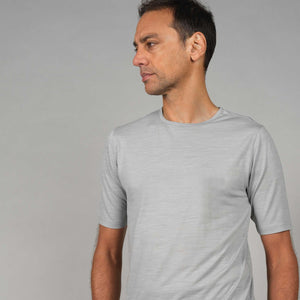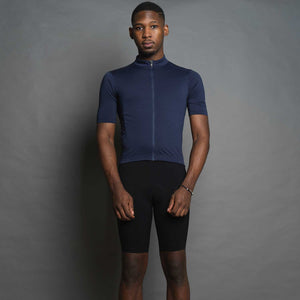Winter is a harsh season for cycling, but often uniquely stunning. Alongside the biting cold and driving rain are those crisp morning rides through quiet country lanes. Of course, to enjoy winter riding, and benefit from winter training, means selecting kit that protects but also offers breathability and ventilation.
So as autumn turns to winter, ashmei has a host of clothing technology to keep riders warm, and training ticking over.

Winter survival tips
Warmth and insulation
The cold is the great enemy of cycling in winter – being chilly can be uncomfortable and inefficient, and being very cold can be dangerous. Layering is always one solution to remaining warm, but looking out for windstopper fabrics, insulation and protective membranes in apparel is arguably more important. That’s because one protective layer can be more effective on the bike than many permeable ones.
Water resistance
The term ‘waterproof’ gets thrown around a lot, and few performance cycling garments deliver true waterproofing across the entire design. Many may have waterproof panels, but to actually protect from rain it’s best to look out for taped seams and water-repellant zips. When deployed well, water-resistance membranes within fabrics and treatments such as Durable Water Repellent (DWR) mean that far less water will get through to the rider – preserving warmth and energy. While many brands use DWR treatment, ashmei prioritises PFC-free DWR to reduce the environmental impact.
It’s worth weighing up the benefits of a removable outer shell rain cape against a single garment that offers water protection. Thankfully we have both.

Breathability
Breathability is often a criteria riders look for in a summer kit, but in the winter it can prove more important. When using water-resistive materials excess heat and sweat can be inefficient and unhygienic. Key to achieving that is the use of microporous materials, where Merino wool is a natural wonder. Using breathable panels of material selectively can mean that a garment can ventilate where heat and sweat tend to build-up, while more protective materials can be used where the body is more exposed to the elements.
Visibility
It’s an unfortunate reality of Earth’s axial tilt that the coldest and rainiest months of the year are also the darkest. It means that while we try to stay warm out on the roads, it’s more important than ever to stay visible. Most of ashmei’s winter kit has reflective detailing and panels of material, meaning that even though some may be dark in colour it will flash against a set of headlights. For low light conditions, a contrast of light and dark colours often offers greater visibility than single-colour garments.
The Kit List | What to wear

Merino Cycle Soft Shell jacket (Men’s and Women’s)
Our soft shell jacket offers insulation and water resistance but is engineered around breathability. It uses a membrane on the front of the jacket and the shoulders that l boasts 10,000mm of waterproofing against 10,000g/m² of breathability – protecting from rain and wind while coping well during heavy efforts.
The rear panel doesn’t need the same wind and water resistance, and so is far more breathable – acting as a type of thermal regulator for the jacket.
The detail of the soft shell is where it really shines, though. It includes a water-resistant Aquaguard zip, a waterproof pocket featuring an internal pump loop and a magnetic flap at the rear to offer more rear cover against road-spray. Given the short daylight hours of the winter months, the reflective detailing is also a subtle but important feature.

Men's Cycle Windjacket
A packable wind jacket can provide protection that’s less likely to leave you sweating than bulkier alternatives, while a lightweight wind barrier can offer some more technical features.
The ashmei Men's Windjacket delivers the benefit of both. It can be worn all day or stashed into a jersey pocket. Similar to the softshell, the jacket uses a windproof, water-resistant fabric across the front panels, but a stretchier and more breathable material across the back. That means it’s versatile enough to protect from cold conditions when soft pedalling in cold rainy conditions but can breathe enough to reduce sweat during heavy efforts. That’s complemented by laser-cut perforations on the rear further aid ventilation.

Merino Thermal Bib Tights (Men’s & Women’s)
Bib tights lend themselves to the coolest days in the saddle, where removable knee or leg warmers are unlikely to be necessary. Our merino thermal bib tights don’t have a pad inside, which means that through the winter months you can switch bibshorts day-to-day without having to wash the tights as often. A second layer also offers a little more insulation, making these ideal for deep winter rides.
The tights offer considerable protection from the elements, with a PFC-free DWR treatment to repel water. The tights’ upper acts like a baselayer, with a high-zip to offer some temperature control, and is made from ashmei’s unique Merino + Carbon fabric.

Men's Padded Thermal Merino 3/4 Bib Shorts
If you prefer a set of winter bibs that include a chamois, and a little more versatility, ashmei’s Padded Thermal Merino ¾ shorts offer a highly technical yet simple design. Spending three years in development, the shorts offer a semi-compressive fit which hugs the lower body, alongside a wind and water resistant microfibre and an environmentally-friendly PFC-free DWR finish. The baselayer-like upper uses the same Merino + Carbon fabric as used on the bib tights.
Given the low-light setting of much winter riding, reflective detailing will offer some much needed visibility.
Glove system

Windproof Glove & Merino Glove
Layering makes most sense when it comes to the hands. While both of our gloves can be used in isolation, together they offer an effective modal glove system.
Our Merino gloves are well suited to autumn and spring conditions, offering warmth and wind protection while weighing very little and can be easily stashed away in a back pocket. When the temperature dips down further, these provide a great liner for the Windproof glove.
Using our three season fabric, the Windproof Gloves offer considerable protection. Yet with the use of a large silicon gripper they also don’t sacrifice dexterity or tactility. On their own they would suit conditions down toward 0°, but in conjunction with the Merino liner they are ready for deep winter freezing conditions.



